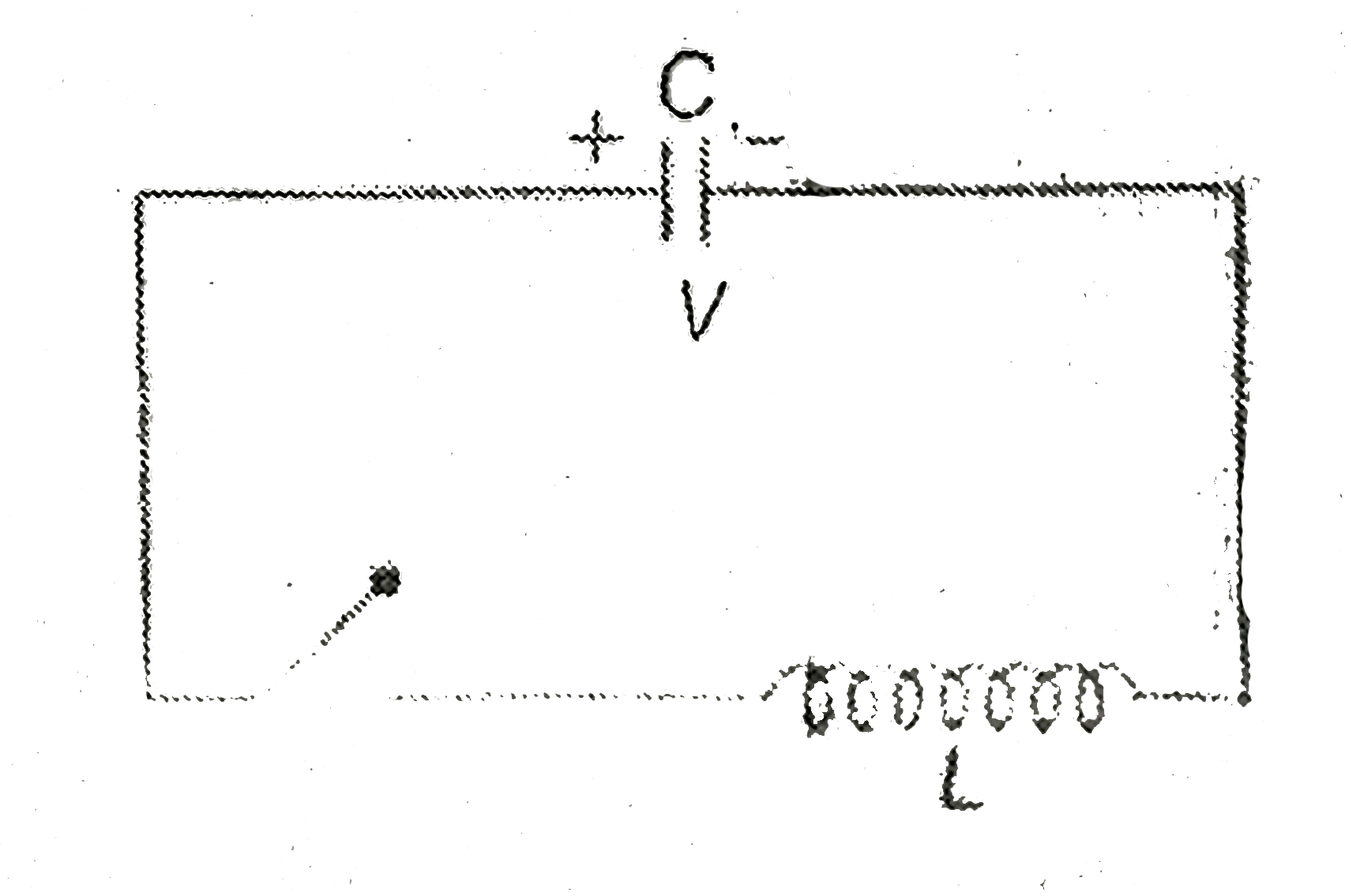A capacitor of capacitance 100μF is connected to a battery of 20 volts for a long time and then disconnected from it. It is now connected across a long solenoid having 4000 turns per meter. It is found that the potential difference across the capacitor drops to 90∘ of its maximum value in 2.0 seconds. Estimate the average magnetic field produced at the centre of the solenoid during this period.
To solve the problem step by step, we will follow the given information and apply the relevant formulas.
Step 1: Identify the given values
- Capacitance, C=100μF=100×10−6F
- Voltage, V=20V
- Turns per meter of the solenoid, n=4000turns/m
- Time, t=2s
Step 2: Calculate the initial charge on the capacitor
The charge Q on the capacitor when fully charged is given by the formula:
Q=C⋅V
Substituting the values:
Q=(100×10−6F)⋅(20V)=2×10−3C=2mC
Step 3: Determine the voltage across the capacitor after 2 seconds
The problem states that the potential difference across the capacitor drops to 90% of its maximum value. Thus:
V′=0.9⋅V=0.9⋅20V=18V
Step 4: Calculate the charge remaining on the capacitor
Using the new voltage V′, we can find the new charge Q′:
Q′=C⋅V′=(100×10−6F)⋅(18V)=1.8×10−3C=1.8mC
Step 5: Calculate the current flowing through the solenoid
The current I can be calculated using the change in charge over time:
I=Q−Q′t=2×10−3C−1.8×10−3C2s=0.2×10−3C2s=0.1×10−3A=0.1mA
Step 6: Calculate the magnetic field in the solenoid
The magnetic field B inside a solenoid is given by the formula:
B=μ0⋅n⋅I
Where μ0=4π×10−7T⋅m/A. Substituting the values:
B=(4π×10−7T⋅m/A)⋅(4000turns/m)⋅(0.1×10−3A)
Calculating this gives:
B=4π×10−7⋅4000⋅0.1×10−3=16π×10−8T
Final Answer
The average magnetic field produced at the center of the solenoid during this period is:
B≈16π×10−8T≈5.03×10−7T
- Capacitance, C=100μF=100×10−6F
- Voltage, V=20V
- Turns per meter of the solenoid, n=4000turns/m
- Time, t=2s
The charge Q on the capacitor when fully charged is given by the formula:
Q=C⋅V
Substituting the values:
Q=(100×10−6F)⋅(20V)=2×10−3C=2mC
The problem states that the potential difference across the capacitor drops to 90% of its maximum value. Thus:
V′=0.9⋅V=0.9⋅20V=18V
Using the new voltage V′, we can find the new charge Q′:
Q′=C⋅V′=(100×10−6F)⋅(18V)=1.8×10−3C=1.8mC
The current I can be calculated using the change in charge over time:
I=Q−Q′t=2×10−3C−1.8×10−3C2s=0.2×10−3C2s=0.1×10−3A=0.1mA
The magnetic field B inside a solenoid is given by the formula:
B=μ0⋅n⋅I
Where μ0=4π×10−7T⋅m/A. Substituting the values:
B=(4π×10−7T⋅m/A)⋅(4000turns/m)⋅(0.1×10−3A)
Calculating this gives:
B=4π×10−7⋅4000⋅0.1×10−3=16π×10−8T
The average magnetic field produced at the center of the solenoid during this period is:
B≈16π×10−8T≈5.03×10−7T
Topper's Solved these Questions
- MAGNETIC FIELD DUE TO CURRENTBOOK - HC VERMA ENGLISHCHAPTER - MAGNETIC FIELD DUE TO CURRENTEXERCISE - questions for short answer
12 Videos
- MAGNETIC FIELD DUE TO CURRENTBOOK - HC VERMA ENGLISHCHAPTER - MAGNETIC FIELD DUE TO CURRENTEXERCISE - Objective 2
7 Videos
- MAGNETIC FIELDBOOK - HC VERMA ENGLISHCHAPTER - MAGNETIC FIELDEXERCISE - objective2
9 Videos
- MAGNETIC PROPERTIES OF MATTERBOOK - HC VERMA ENGLISHCHAPTER - MAGNETIC PROPERTIES OF MATTEREXERCISE - Short Answer
6 Videos
Similar Questions
An uncharged capacitor of capacitance 100μF is connected to a battery of emf 20V at t = 0 through a resistance 10Ω, then
(ii) time at which the rate has time miximum value is
View SolutionA capacitor of capacitance value 1μF is charged to 30 V and the battery is then disconnected. If it is connected across a 2μF capacotor, then the energy lost by the system is
View SolutionA capacitor of capacitance 10μF is charged to a potential 50V with a battery. The battery is now disconnected and an additional charge 200μC is given to the positive plate of the capacitor. The potential difference across the capacitor will be.
View SolutionA capacitor of capacitance 1μF is connected in parallel with a resistance 10Ω and the combination is connected across the terminals of a battery of EMF 50 V and internal resistance 1Ω. The potential difference across the capacitor at steady state is (in Volt)
View SolutionA capacitor is connected to a 12 V battery through a resistance of (10Ω).It is found that the potential difference across the capacitor rises to 4.0 V in 1(mu)s. find the capacitance of the capacitor.
View SolutionAn ideal capacitor of capacitance 0.2μF is charged to a potential difference of 10V. The charging battery is than disconnected. The capacitor is then connected to an ideal inductor of self inductance 0.5mH. The current at a time when the potential difference across the capacitor is 5V is :
View SolutionA capacitor of capacitnace C is charged to a potential difference V and then disconnected from the battery. Now it is connected to an inductor of inductance L at t=0. Then

View SolutionAn uncharged capacitor of capacitance 100μF is connected to a battery of emf 20V at t = 0 through a resistance 10Ω, then
(i) the maximum rate at which energy is stored in the capacitor is :
View SolutionAn uncharged capacitor of capacitance 100μF is connected to a battery of emf 20V at t = 0 through a resistance 10Ω, then
(i) the maximum rate at which energy is stored in the capacitor is :
View SolutionA capacitor of capacity 2μF is changed to a potential different of 12V . It is then connected across an inductor of inductance 0.6mH What is the current in the circuit at a time when the potential difference across the capacitor is 6.0V ?
View Solution
